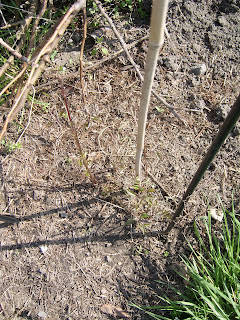Time is short. People often think they don't have enough to maintain a kitchen garden. This week I had just twenty minutes to spare. So I picked rhubarb and a little asparagus and shot these pictures hastily. An overview of what's happening on the plot. We're about three weeks late with Spring this year. Generally (and without having attended a permaculture training course - I've adopted many permaculture principles. Many of them are just sensible and helpful for people who don't have much time, or people who have physicial challanges. I don't dig, some people like it - but no-dig gardeners have been having success with this approach for years now and we do too.
Long awaited daffodills and an apple tree (around fifty years old) - one of two inherited from previous plot holders. I pruned it heavily in previous years and it still fruits well. It's our plot-and-a-half's fourth birthday in June. We converted it from derelict. (And I mean derelict). I shot these pictures with an automatic, compact camera - the colour is a bit iffy, but for documentative purposes they've presentable. Hope you like them.
Comfrey. An essential ingredient of any organic garden. I harvest it three times a year, wilt it and use it as a compost activator. I'm pleased to say that we haven't burned any of our green waste in four years. Composting is much faster with comfrey and it can also be used as a plant food or a mulch. Although soaking it in water is too much faff for me and it smells terrible. You can also feed it to rabbits (in small amounts) and chickens.
The picture above on the right is a Cherry Plum. I keep them small and they provide a good wind break. It's flowering for the first time in it's third year.
Garlic made it through the severe winter - whereas the autumn sown onions didn't. They usually do very well, so I've planted red onions instead, along with lots of spring onions and winter hardy spring onions. 
Raspberries. I've treated all these as if they were autumn fruiting i.e. cut them down to the ground in the autumn. here they are coming up again. It's quite dry at the moment, of course the sunshine is lovely but we do need some rain. I hardly every water anything unless it is newly planted. Luckily we have clay soil which looks dry on top but the this type of soil holds a lot of water and so just underneath the surface it is actually quite moist.
The next picture shows our second bed of raspberries which were planted in autumn.
The plant in the picture on the right is an important one. Poached Egg Plant. I sowed a few in early spring last year and they've survived the winter brilliantly. Of course they're fantastic for pollinators like bumble bees and the hoverflies like them too. And they're very low-maintenance plants. They self-seed. If you've got too many, they are easy to pull up and put on the compost heap.
Blackcurrant bushes. (Seem to have mislaid this picture). Three of them in all. One is quite small at the moment. I'm using the destructive pruning method as mentioned in the Encyclopedia of Organic Gardening. That means instead of pruning individual branches you cut all branches down on one in three of your bushes each year. So you still have two fruiting ones. This saves time and the blackcurrants seem to respond well.
Two rhubarb plants, looking healthy. We'll be able to pick some this year. They were planted the autumn before last.
Rosemary. This one is for the bees really. It is usually the first bush to flower.
This is our pear tree in it's third year now. Can't remember the variety (always write it down!) but I do remember it's September-fruiting.In this air-brushed media world of ours - I feel social realism is important! We need to think about what didn't work as well as our successes! These broad beans were a victim of the poor weather we've had. I planted them in root trainers at the usual time and they didn't germinate well in our courtyard. Then the frost got them and they lost their tops. The good news is, that in year four of our clay soil allotment we've improved the soil so much with the compost we've made and the rabbit manure we added - that we can now sow more things directly. Less work I hope.
 You can only just about see these, but on the right here the asparagus is coming up now. It's been a long wait. We can't harvest much this year, but they're delicious!
You can only just about see these, but on the right here the asparagus is coming up now. It's been a long wait. We can't harvest much this year, but they're delicious! |
| Very happy to see that this clematis my mother gave me made it through the winter |
 |
| Some Little Gem lettuces I planted out. We could do with some rain. |










